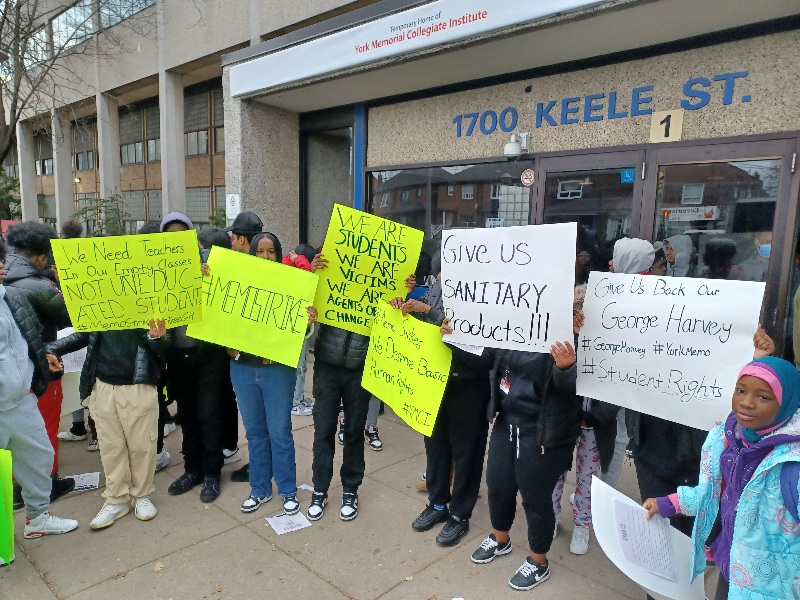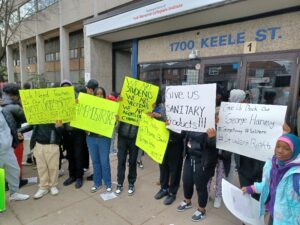Education at TDSB: “woke” yes, “awake” not so much
TORONTO – The demonstration by students, on Friday, December 2 (here our article), at the combined high school on Keele Street (George Harvey and York Memorial) was impressive for several reasons. One, it was peaceful and generally well-tempered. Two, at its peak, there were, by my rough count (contested by other Media reports interested in inflating numbers), about 150 participants (just over 10% of the registered student body). Three, students were prepared to deliver a message in response to the extremely negative publicity their school(s) garnered in recent press and media reports.
Good. For what it is worth, the mere fact that the “walk-out” took place suggests some are concerned that the schools and their students are getting “short shrift”.
Basically, from reports and counter allegations, everyone can agree that the sanitation conditions at the school leave much to be desired. Washrooms are not cleaned regularly, absence of toilet paper, soap for washing, unavailability of women’s hygiene products, washroom stalls without doors or with malfunctioning ones that do not ensure privacy. We were not invited to tour the school.
CUPE, the Union whose members are responsible for the “physical maintenance” of the school, were neither present at the demonstration nor mentioned. They have been a central player in the recent stand-off to get the Provincial Government to increase their pay package, threatening to close the schools if they did not get their way.
From an “in classroom” perspective, students complained that, in some instances, they have yet to meet their homeroom teacher – that would be the one who “sets the day for them from an administrative point of view”. Others indicated the absence of their subject teachers for days on end, with no replacement. There were also no identified teachers in the demonstration, although a couple of them at the school entrance said they had no problems with the protest, having advised the students their “non-objection” was conditioned on the students’ willingness to be respectful.
If nothing else, the students were compliant, acknowledging that there are some really good teachers, although one of the student presenters underscored the lack of interest on the part of the teachers’ union, OSSTF. This group is up next in the negotiations round. The tantalizing question raised is “who is at fault” for the mayhem at the school?
Incredibly, no one could or would identify the name of the principal, or any of the vice-principals – the administrators. The picture painted of these administrators is that they also swore off their duties and obligations (no one wants those jobs, so they stay away). Is it any wonder, some students asked rhetorically, that there are fights in the school. The students themselves claim innocence.
When prodded if police presence would help, they reacted negatively at the mere suggestion that officers should be in the school. In fact, they are painted as a negative, threatening element. Interestingly, there was not a police officer or police vehicle in sight during the march. A police station is situated about one kilometre West from the York Memorial site now under reconstruction.
Several activist members of a local Community Hub (publicly funded) appear to have filled the vacuum of teacher/guidance counsellors and advisors to the students for the event. They seemed to have kept a “tight control” on any potentially overly boisterous activity. Compliments to them. In the communications sector it is important to stay on message. Since they apparently serve as advisors to the police, it is not too much of a stretch to suggest that the “police absence” probably reflected their input.
They probably also had something to do with the almost last-minute appearance of the Director, Colleen Russell-Rawlins. As a personal aside, I thought she demonstrated courage by her attendance. Super mayor John Tory was otherwise occupied. She agreed to meet with student representatives on their issues and to take action accordingly.
Students talked almost exclusively about the “nuts and bolts” of education – the reading [w]riting and [a]rithmetic necessary to move along in life. The TDSB is top heavy in senior administrators (forty seven, 47) whose focus is best encapsulated by “the current capacities required of leaders to identify and eliminate the systemic, local and individual forms of discrimination (e.g., anti-Indigenous racism, anti-Black racism, antisemitism, Islamophobia, anti-Asian racism, anti-South Asian racism, ableism, homophobia and transphobia), hate and oppression” according to its website.
The organizational chart of the TDSB reveals an apex team of seven individuals at the director or associate director level (five of them female), seven other members of the leadership team (four of them female), six System Superintendents, twenty-eight other superintendents divided among four learning centres (seven superintendents for each). In total, among all groups twenty-nine are females, twenty-six of the overall total are from visible minorities.
One might expect that the leadership would be well-equipped to understand the challenges of the students demonstrating against their learning conditions. Only three of them were not from a visible minority. They all appeared to clamour for a “structured educational process”.
The Fraser Institute, ranks participating Ontario secondary schools according to the score obtained by grade nine students on EQAO standardized testing. Pre-Covid, 2018-2019, those results placed York Memorial at 524 out of a total 739 schools. The average score was 5.1 out of 10. George Harvey ranked 708 out of 739 with an average score of 2.4.
The demonstrators were screaming “we want to learn”. The problems precede grade nine and today’s difficulties.




